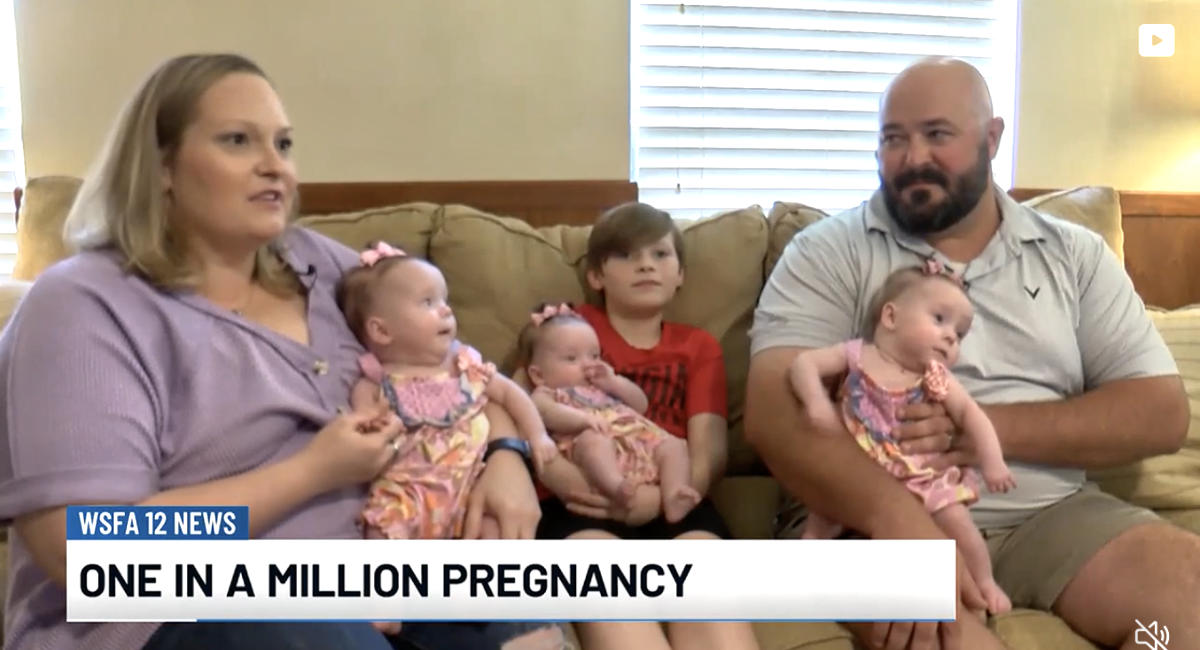After 10 years of believing they were unable to have more children, Brittany Ingram and her husband, Josh, learned last year they were expecting not just one baby — but three.
In February this year, the Alabama couple welcomed identical triplets to join their 10-year-old son JB — baby girls Emersyn Claire, Adalyn Renae, and Layla Michele.
Key Takeaways:
- The Ingrams did not use assisted reproductive technology; they conceived their triplet daughters naturally.
- Monochorionic triamniotic triplets (genetically identical triplets sharing a placenta) are extremely rare.
- Restorative Reproductive Medicine, which Brittany Ingram used to conceive their first child, a son, is being used more frequently with great success, and at much lower cost than IVF.
The Backstory:
Brittany, 36, was diagnosed a decade ago with endometriosis and polycystic ovary syndrome (PCOS), conditions which affect female fertility. Doctors warned her it would be difficult for her to conceive at all. After undergoing a laparoscopy to remove the cysts on her ovaries, Brittany conceived and gave birth to the couple’s son, JB, naturally.
Brittany told Good Morning America (GMA) that she Josh tried to have more children afterward but suffered the heartbreaking loss of a child through miscarriage.
The couple decided against using assisted reproductive technology.
“I’ve seen so much heartbreak with the IVF journeys and stuff, and I was like, ‘I’ve got my one, I’ll just love on him,’” Brittany told WSFA 120.
Brittany and Josh decided to surrender their family’s future into God’s hands.
“We were just kind of leaving it up to God, and saying, ‘If it’s meant to be, it’ll be. If it’s not, it won’t,'” Brittany told GMA, “So, after 10 years, we just thought JB was going to be our one and only [child].”
The Details:
It was the week of Brittany’s 36th birthday in August of 2024 when the Ingrams learned they were expecting monochorionic triamniotic triplets — genetically identical triplets who share a single placenta.
“It’s an extremely rare phenomenon, with an estimated incidence of only 1 in 100,000 to 200,000 pregnancies,” Brittany’s doctor, Ayodeji Sanusi, said.
Brittany was considered to have a high-risk pregnancy and was placed on bed rest at 19 weeks.
But premature labor began at 22 weeks, and after careful consultation, doctors treated her with cervical cerclage, sewing her cervix closed so that she was able to carry the babies until 30 weeks gestation.
After their delivery, Brittany was treated and stabilized for her complications, which included postpartum preeclampsia, cardiomyopathy, and heart failure.
The triplets stayed in the neonatal intensive care unit for about two months before going home healthy.
Brittany hopes their story will encourage others who have struggled with infertility. “Don’t give up. There’s always hope,” she said. “Just because it’s not on your timing doesn’t mean it’s not ever going to happen.”
What’s Happening:
Restorative Reproductive Medicine is increasingly being used to help heal women’s bodies, simultaneously enabling women to conceive children naturally.
As in Brittany’s case, many women diagnosed with infertility due to endometriosis and PCOS have been able to conceive after a laparoscopy and treatment of their underlying fertility issues.
Maria Armstrong and her husband Jordan were told by doctors that they suffered from unexplained infertility. The couple turned to multiple rounds of fertility ‘treatments,’ including intrauterine insemination and IVF, which did not help them conceive. After Maria received laparoscopic surgery, was diagnosed with stage-two endometriosis, and subsequently underwent endometrial surgery, she conceived a baby naturally.
At Live Action’s first Women’s Summit, Dr. Lauren Rubal described how Restorative Reproductive Medicine is effective and also honors the female body’s natural design.
“Instead of suppressing, overriding, or outsourcing our fertility, Restorative Reproductive Medicine cooperates with it. It treats infertility as a chronic condition, not an episodic one, and it respects the whole person, body, mind, and soul. It’s ethical. It’s evidence-based, and in fact it’s actually just as effective, if not more so, than IVF.”
“Studies show that RRM have birth rates that rival IVF, with far fewer risks and at a fraction of the cost.”
Follow Live Action News on Facebook and Instagram for more pro-life news.







